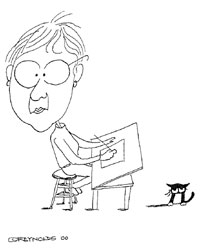| ||
Great geezer artists by Jules Masterjohn Creativity can be defined as one’s ability to use imagination to develop new and original ideas or things, especially in an artistic context. Curiosity drives the imagination. A sense of wonder and openness to experience are qualities found in the attitudes of deeply creative people. The subject of creativity and aging has been consuming local journalist and art historian, Judith Reynolds, for the last three months. She has been excitedly researching her upcoming lecture, “From Michaelangelo to Matisse: Creative Expression in Old Age.” The topic, “,” as Reynolds humorously calls it, examines the late works of master artists from the Renaissance through the 20th century. “I am curious about how creative output changes over time, curious about the patterns and paths that show up,” she said. During her research for the illustrated lecture, she encountered some “incredibly heroic stories” about artists who, facing the “obstacles of health” continued to be productive into their 80s and 90s. Reynolds will hand out a list of more than 40 artists who lived to be 75 years or older and many on the list are included in her lecture. Among the numerous art historical images that Reynolds will share is the last sculpture that Michaelangelo carved before his death at age 89. Her survey list includes other Italian Renaissance greats like Bernini and Titian; Spanish genius Goya; French court painter Vigee-Lebrun; modern European masters Degas, Rodin and Matisse; as well as American idols O’Keeffe, Hopper, Noguchi and de Kooning. Pablo Picasso, “undoubtedly one of the most influential artists of the 20th century,” is one of three artists that Reynolds will highlight. He is a fitting subject to focus on this week: the 125th anniversary of his birth was Oct. 25, one day before Reynolds’ talk. Thanks to Reynolds, Durango will join New York and Barcelona, among other cities worldwide that are honoring Picasso’s amazingly long and productive creative life. “I really wanted to have the lecture on Picasso’s birthday but the Life-Long Learning lectures are always scheduled on Thursdays, so I settled for the day after,” Reynolds said. She would know the ins and outs of planning these lectures – the Fort Lewis College sponsored lecture series was her brainchild. “After I moved to Durango, I realized that there were professors, retired professors and young retirees that had a wealth of knowledge to share. The resources here are tremendous.” Reynolds, with the blessing and assistance of the Professional Associates of Fort Lewis College, undertook what became a part-time, volunteer job for a number of years. “I wanted to live in a town where there was a program like this, and since there wasn’t, I had to create it,” she said. “What’s important about this lecture series is that it offers professional people the opportunity to stay engaged and make a contribution to society.” Unquestionably, Reynolds’ curiosity, energy, and professionalism have added tremendously to our community. Along with being a regular lecturer on art topics offered in the Life-Long Learning Lecture Series, her informative arts critiques in the local press offer insights that place the visual art, concert piece or theatrical play into a socio-political and historical context, helping readers to understand the greater purpose of creative activities. “Art makes us more human. Through art we can encounter all human experience and connect us to time, continents and cultures,” she enthusiastically said.
Having participated in the performing and visual arts since she was a girl, Reynolds has an affinity for the creative spirit. Each of the arts was a large part of her young life. In college, she chose to pursue the visual arts instead of music and focused her passion on painting to become a visual art major. While studying at the University of Michigan in Ann Arbor, she had a professor who, through his engaging lectures, challenged students to “question absolutely everything.” He turned Reynolds on to what would become one of her lifelong passions, art history. She recalled, “It was spellbinding to be aware that, as an artist, you were part of this huge arc of history.” She went on to study art history, and in 1963, completed a master’s degree with a focus on American Romantic landscape painting. Within a few years, having finished her coursework toward a doctoral degree in Baroque art, Reynolds lost passion for the subject and never wrote her dissertation. With the social upheaval in the ’60s and values being questioned throughout society, she began to re-evaluate the validity of art history as a profession and instead, looked toward a career in social work. Inspired once again by an art history professor, she credits his lecture topic, “Art is long, art is forever, life is brief,” as a pivotal moment in her decision-making process. She chose the arts forever, and she has never looked back. Reynolds’ voracity for newness and a desire for intellectual challenge propelled her from public school art teacher, art history professor and college administrator into the world of journalism. Asked to become the art critic for the weekly City Newspaper in Rochester, N.Y., she jumped at the chance. After 15 years in academia, Reynolds shifted professions and took a position as the arts editor, then became the managing editor of the paper. “I love being a newspaper writer; you’re always on the learning curve,” she said. “It’s high responsibility, high speed, very public and intellectually demanding.” Given Reynolds’ energetic and inquisitive temperament, her mid-life career shift was a perfect fit. Not yet old enough to meet her own criteria as a great geezer artist, there seems no doubt that with her intense joie de vivre, Reynolds will someday be included on someone’s list of engaged, socially conscious Durangoans who have made our community a more creative and interesting place to live. Do not miss Reynolds’ lecture. She is an engaging, enthusiastic and articulate speaker who addresses her audience with humor and intelligence. Her inquisitiveness and love of learning are infectious. •
|


